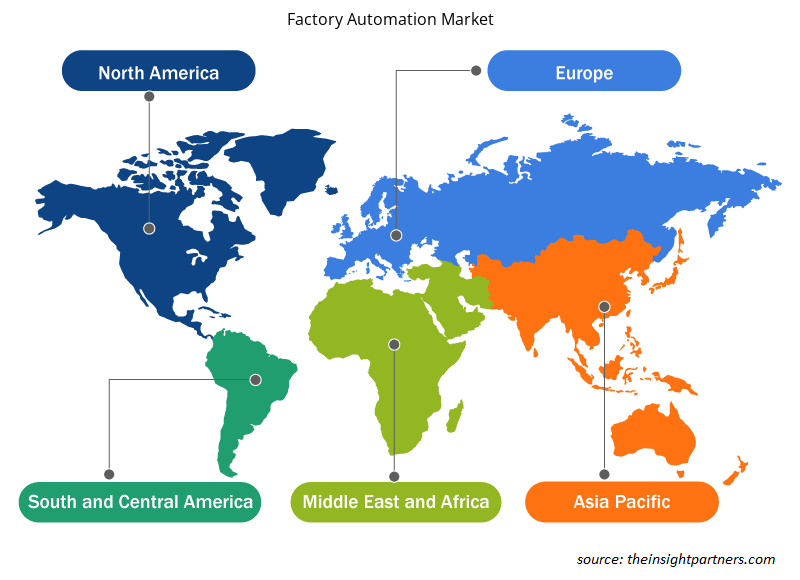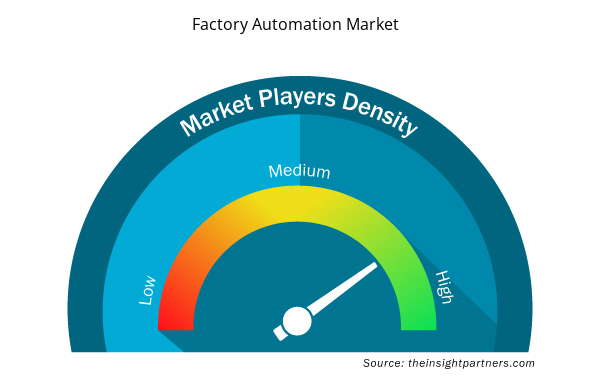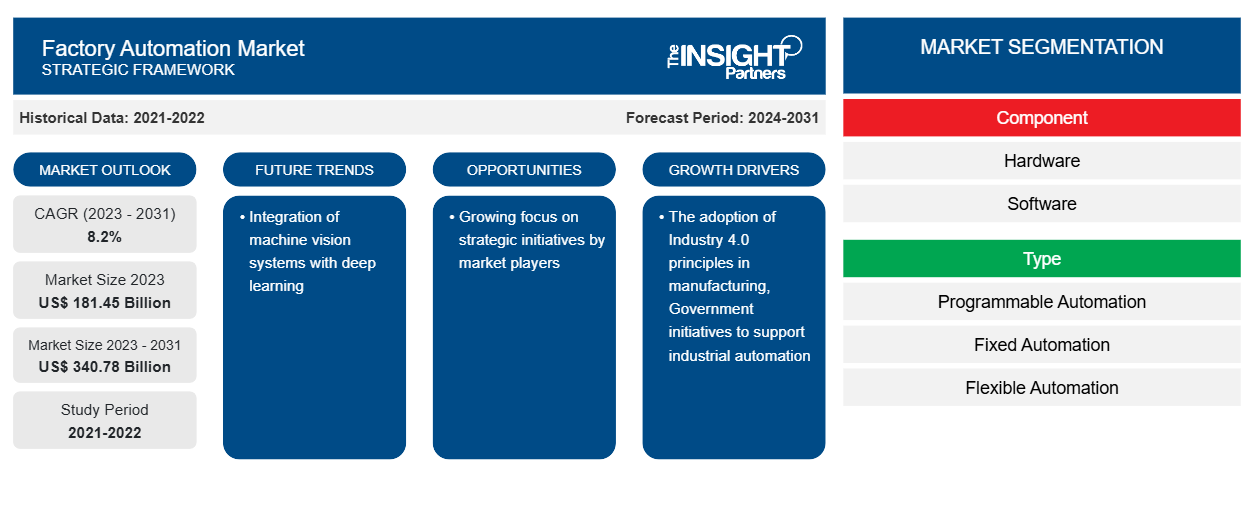Si prevede che il mercato dell'automazione di fabbrica crescerà da 181,45 miliardi di dollari nel 2023 a 340,78 miliardi di dollari entro il 2031; si prevede che si espanderà a un CAGR dell'8,2% dal 2023 al 2031. Si prevede che l'integrazione dei sistemi di visione artificiale con l'apprendimento profondo sarà una tendenza chiave nel mercato.
Analisi di mercato dell'automazione di fabbrica
Il settore manifatturiero si è espanso rapidamente nell'ultimo decennio. La globalizzazione sta espandendo il mercato, attraendo un gran numero di nuovi attori. Il vantaggio competitivo nel mercato dell'automazione di fabbrica per le aziende chiave può essere costruito attraverso la differenziazione del prodotto, la leadership di costo, il marketing mirato e un ottimo servizio post-vendita. L'automazione è un fattore critico per i processi di produzione. Inoltre, le soluzioni di automazione avanzate consentono di ottenere costantemente alta qualità, elevata produttività e bassi costi di produzione. Pertanto, si prevede che il mercato dell'automazione di fabbrica crescerà durante il periodo di previsione.
Panoramica del mercato dell'automazione di fabbrica
L'automazione di fabbrica è l'integrazione dell'automazione in tutte le fasi del processo di produzione. L'automazione nella produzione combina spesso tecnologie come sistemi pneumatici , sistemi idraulici e bracci robotici per produrre un sistema più complicato. In un ambiente competitivo, l'automazione di fabbrica può aiutare ad aumentare la produzione e l'efficienza riducendo al contempo i costi. L'automazione di fabbrica fornisce un metodo convincente per aumentare l'efficienza, la qualità, la sostenibilità, la sicurezza e la protezione in un ambiente di fabbrica moderno in rapida evoluzione.
Personalizza questo report in base alle tue esigenze
Riceverai la personalizzazione gratuita di qualsiasi report, comprese parti di questo report, o analisi a livello nazionale, pacchetto dati Excel, oltre a usufruire di grandi offerte e sconti per start-up e università
- Scopri le principali tendenze di mercato in questo rapporto.Questo campione GRATUITO includerà analisi di dati che spaziano dalle tendenze di mercato alle stime e alle previsioni.
Driver di mercato e opportunità dell'automazione di fabbrica
Adozione del principio dell'Industria 4.0 nel settore manifatturiero per favorire la crescita del mercato.
Il potere rivoluzionario della quarta rivoluzione industriale (Industria 4.0) sta modificando la produzione globale. L'Industria 4.0, che è definita (in parte) da sistemi intelligenti, intelligenza artificiale (IA), big data e architettura IT avanzata, rappresenta il passo successivo nell'evoluzione della produzione nel suo complesso e molte aziende stanno adottando queste tecnologie. I vantaggi dei processi, delle tecnologie e dei sistemi dell'Industria 4.0 includono produttività ed efficienza migliorate, maggiore agilità e flessibilità e maggiore redditività. Pertanto, si prevede che l'adozione dell'Industria 4.0 per l'automazione in numerosi settori alimenterà la crescita del mercato dell'automazione di fabbrica durante il periodo di previsione.
Crescente attenzione alle iniziative strategiche da parte degli operatori del mercato
Si prevede che la crescente attenzione dei principali partecipanti al mercato su attività strategiche come fusioni, acquisizioni e collaborazioni, tra le altre, stimolerà la crescita del mercato dell'automazione di fabbrica. Ad esempio, a luglio 2021, Rockwell Automation, Inc., impegnata nell'automazione industriale e nella trasformazione digitale, ha annunciato l'acquisizione di Plex Systems, la principale piattaforma di produzione intelligente cloud-native. Inoltre, a settembre 2021, Rockwell Automation, Inc. ha annunciato una partnership con Kezzler, una piattaforma di digitalizzazione e tracciabilità dei prodotti basata su cloud, per aiutare i produttori a catturare il percorso dei loro prodotti dalle fonti di materie prime al punto vendita o oltre utilizzando soluzioni di supply chain basate su cloud che si concentrano sulla tracciabilità dei prodotti.Plex Systems, the leading cloud-native smart manufacturing platform. Further, in September 2021, Rockwell Automation, Inc. announced a partnership with Kezzler, a cloud-based product digitization and traceability platform, to help manufacturers capture the journey of their products from raw material sources to point-of-sale or beyond using cloud-based supply chain solutions that focus on product traceability.
Analisi della segmentazione del rapporto di mercato sull'automazione di fabbrica
I segmenti chiave che hanno contribuito alla derivazione dell'analisi di mercato dell'automazione di fabbrica sono componenti, tipologia, tecnologia e settore verticale.
- In base ai componenti, il mercato si divide in hardware e software
- In base al tipo, il mercato è suddiviso in automazione programmabile, automazione fissa e automazione flessibile).
- In base alla tecnologia, il mercato è suddiviso in controllori logici programmabili (PLC), sistemi di controllo distribuito (DCS), sistemi di controllo di supervisione e acquisizione dati (SCADA), interfaccia uomo-macchina (HMI) e altri.
- In base al settore verticale, il mercato è suddiviso in automotive, alimentare e delle bevande, petrolio e gas, manifatturiero, minerario e altri.
Analisi della quota di mercato dell'automazione di fabbrica per area geografica
In base alla regione, il mercato è segmentato in Nord America, Europa, Asia Pacifico, Medio Oriente e Africa, Sud e Centro America.
Si prevede che il Nord America deterrà una quota importante del mercato dell'automazione di fabbrica durante il periodo di previsione. Questa crescita può essere attribuita all'adozione tecnologica precoce e a una forte enfasi sulle attività di ricerca e sviluppo. Inoltre, si prevede che la crescente popolarità dei robot collaborativi e delle iniziative governative per la trasformazione digitale in tutti i settori alimenterà il mercato dell'automazione di fabbrica durante il periodo di previsione.
Approfondimenti regionali sul mercato dell'automazione di fabbrica
Le tendenze regionali e i fattori che influenzano il mercato dell'automazione di fabbrica durante il periodo di previsione sono stati ampiamente spiegati dagli analisti di Insight Partners. Questa sezione discute anche i segmenti e la geografia del mercato dell'automazione di fabbrica in Nord America, Europa, Asia Pacifico, Medio Oriente e Africa e America meridionale e centrale.

- Ottieni i dati specifici regionali per il mercato dell'automazione di fabbrica
Ambito del rapporto sul mercato dell'automazione di fabbrica
| Attributo del report | Dettagli |
|---|---|
| Dimensioni del mercato nel 2023 | 181,45 miliardi di dollari USA |
| Dimensioni del mercato entro il 2031 | 340,78 miliardi di dollari USA |
| CAGR globale (2023-2031) | 8,2% |
| Dati storici | 2021-2022 |
| Periodo di previsione | 2024-2031 |
| Segmenti coperti | Per componente
|
| Regioni e Paesi coperti | America del Nord
|
| Leader di mercato e profili aziendali chiave |
|
Densità degli attori del mercato dell'automazione di fabbrica: comprendere il suo impatto sulle dinamiche aziendali
Il mercato dell'automazione di fabbrica sta crescendo rapidamente, spinto dalla crescente domanda degli utenti finali dovuta a fattori quali l'evoluzione delle preferenze dei consumatori, i progressi tecnologici e una maggiore consapevolezza dei vantaggi del prodotto. Con l'aumento della domanda, le aziende stanno ampliando le loro offerte, innovando per soddisfare le esigenze dei consumatori e capitalizzando sulle tendenze emergenti, il che alimenta ulteriormente la crescita del mercato.
La densità degli operatori di mercato si riferisce alla distribuzione di aziende o società che operano in un particolare mercato o settore. Indica quanti concorrenti (operatori di mercato) sono presenti in un dato spazio di mercato in relazione alle sue dimensioni o al valore di mercato totale.
Le principali aziende che operano nel mercato dell'automazione di fabbrica sono:
- ABB Ltd.
- Azienda Emerson Electric
- Società Fanuc
- Compagnia elettrica generale
- Mitsubishi Electric Corporation
- Honeywell International Inc.
Disclaimer : le aziende elencate sopra non sono classificate secondo un ordine particolare.

- Ottieni una panoramica dei principali attori del mercato dell'automazione di fabbrica
Notizie e sviluppi recenti del mercato dell'automazione di fabbrica
Il mercato dell'automazione di fabbrica viene valutato raccogliendo dati qualitativi e quantitativi dopo la ricerca primaria e secondaria, che include importanti pubblicazioni aziendali, dati associativi e database. Di seguito sono elencati alcuni degli sviluppi nell'automazione di fabbrica:
- Mitsubishi Electric Corporation ha annunciato che investirà circa 2,2 miliardi di rupie indiane, o 3,1 miliardi di yen, nella sua sussidiaria Mitsubishi Electric India Pvt. Ltd. per stabilire una nuova fabbrica in India. La nuova fabbrica, la cui entrata in funzione è prevista per dicembre 2023, produrrà inverter e altri prodotti per sistemi di controllo di automazione di fabbrica (FA), ampliando le capacità dell'azienda per soddisfare la crescente domanda in India. (Fonte: Mitsubishi Electric Corporation, comunicato stampa, giugno 2022)
Copertura e risultati del rapporto sul mercato dell'automazione di fabbrica
Le previsioni di mercato dell'automazione di fabbrica sono stimate in base a vari risultati di ricerche secondarie e primarie, come pubblicazioni aziendali chiave, dati di associazioni e database. Il rapporto di mercato "Dimensioni e previsioni del mercato dell'automazione di fabbrica (2021-2031)" fornisce un'analisi dettagliata del mercato che copre le seguenti aree:
- Dimensioni e previsioni del mercato dell'automazione di fabbrica a livello globale, regionale e nazionale per tutti i segmenti di mercato chiave coperti dall'ambito
- Tendenze del mercato dell'automazione di fabbrica, nonché dinamiche di mercato quali driver, vincoli e opportunità chiave
- Analisi dettagliata delle cinque forze PEST/Porter e SWOT
- Analisi di mercato dell'automazione di fabbrica che copre le principali tendenze di mercato, il quadro globale e regionale, i principali attori, le normative e i recenti sviluppi del mercato
- Analisi del panorama industriale e della concorrenza che copre la concentrazione del mercato, l'analisi della mappa di calore, i principali attori e gli sviluppi recenti nel mercato dell'automazione di fabbrica
- Profili aziendali dettagliati.
- Analisi storica (2 anni), anno base, previsione (7 anni) con CAGR
- Analisi PEST e SWOT
- Valore/volume delle dimensioni del mercato - Globale, regionale, nazionale
- Industria e panorama competitivo
- Set di dati Excel



Report Coverage
Revenue forecast, Company Analysis, Industry landscape, Growth factors, and Trends

Segment Covered
This text is related
to segments covered.

Regional Scope
North America, Europe, Asia Pacific, Middle East & Africa, South & Central America

Country Scope
This text is related
to country scope.
Domande frequenti
The global factory automation market is expected to grow at a CAGR of 8.2% during the forecast period 2024 - 2031.
The adoption of Industry 4.0 principles in manufacturing and government initiatives to support industrial automation are the major factors driving the factory automation market.
Integration of machine vision systems with deep learning to play a significant role in the global factory automation market in the coming years.
The leading players operating in the factory automation market are ABB Ltd., Emerson Electric Co., Fanuc Corporation, General Electric Company, Mitsubishi Electric Corporation, Honeywell International Inc., OMRON Corporation, Rockwell Automation, Inc., and Siemens AG.
North America is expected to dominate the factory automation market with the highest market share in 2023.
The factory automation market size is projected to reach US$ 340.78 billion by 2031.
Trends and growth analysis reports related to Electronics and Semiconductor : READ MORE..
The Insight Partners performs research in 4 major stages: Data Collection & Secondary Research, Primary Research, Data Analysis and Data Triangulation & Final Review.
- Data Collection and Secondary Research:
As a market research and consulting firm operating from a decade, we have published and advised several client across the globe. First step for any study will start with an assessment of currently available data and insights from existing reports. Further, historical and current market information is collected from Investor Presentations, Annual Reports, SEC Filings, etc., and other information related to company’s performance and market positioning are gathered from Paid Databases (Factiva, Hoovers, and Reuters) and various other publications available in public domain.
Several associations trade associates, technical forums, institutes, societies and organization are accessed to gain technical as well as market related insights through their publications such as research papers, blogs and press releases related to the studies are referred to get cues about the market. Further, white papers, journals, magazines, and other news articles published in last 3 years are scrutinized and analyzed to understand the current market trends.
- Primary Research:
The primarily interview analysis comprise of data obtained from industry participants interview and answers to survey questions gathered by in-house primary team.
For primary research, interviews are conducted with industry experts/CEOs/Marketing Managers/VPs/Subject Matter Experts from both demand and supply side to get a 360-degree view of the market. The primary team conducts several interviews based on the complexity of the markets to understand the various market trends and dynamics which makes research more credible and precise.
A typical research interview fulfils the following functions:
- Provides first-hand information on the market size, market trends, growth trends, competitive landscape, and outlook
- Validates and strengthens in-house secondary research findings
- Develops the analysis team’s expertise and market understanding
Primary research involves email interactions and telephone interviews for each market, category, segment, and sub-segment across geographies. The participants who typically take part in such a process include, but are not limited to:
- Industry participants: VPs, business development managers, market intelligence managers and national sales managers
- Outside experts: Valuation experts, research analysts and key opinion leaders specializing in the electronics and semiconductor industry.
Below is the breakup of our primary respondents by company, designation, and region:

Once we receive the confirmation from primary research sources or primary respondents, we finalize the base year market estimation and forecast the data as per the macroeconomic and microeconomic factors assessed during data collection.
- Data Analysis:
Once data is validated through both secondary as well as primary respondents, we finalize the market estimations by hypothesis formulation and factor analysis at regional and country level.
- Macro-Economic Factor Analysis:
We analyse macroeconomic indicators such the gross domestic product (GDP), increase in the demand for goods and services across industries, technological advancement, regional economic growth, governmental policies, the influence of COVID-19, PEST analysis, and other aspects. This analysis aids in setting benchmarks for various nations/regions and approximating market splits. Additionally, the general trend of the aforementioned components aid in determining the market's development possibilities.
- Country Level Data:
Various factors that are especially aligned to the country are taken into account to determine the market size for a certain area and country, including the presence of vendors, such as headquarters and offices, the country's GDP, demand patterns, and industry growth. To comprehend the market dynamics for the nation, a number of growth variables, inhibitors, application areas, and current market trends are researched. The aforementioned elements aid in determining the country's overall market's growth potential.
- Company Profile:
The “Table of Contents” is formulated by listing and analyzing more than 25 - 30 companies operating in the market ecosystem across geographies. However, we profile only 10 companies as a standard practice in our syndicate reports. These 10 companies comprise leading, emerging, and regional players. Nonetheless, our analysis is not restricted to the 10 listed companies, we also analyze other companies present in the market to develop a holistic view and understand the prevailing trends. The “Company Profiles” section in the report covers key facts, business description, products & services, financial information, SWOT analysis, and key developments. The financial information presented is extracted from the annual reports and official documents of the publicly listed companies. Upon collecting the information for the sections of respective companies, we verify them via various primary sources and then compile the data in respective company profiles. The company level information helps us in deriving the base number as well as in forecasting the market size.
- Developing Base Number:
Aggregation of sales statistics (2020-2022) and macro-economic factor, and other secondary and primary research insights are utilized to arrive at base number and related market shares for 2022. The data gaps are identified in this step and relevant market data is analyzed, collected from paid primary interviews or databases. On finalizing the base year market size, forecasts are developed on the basis of macro-economic, industry and market growth factors and company level analysis.
- Data Triangulation and Final Review:
The market findings and base year market size calculations are validated from supply as well as demand side. Demand side validations are based on macro-economic factor analysis and benchmarks for respective regions and countries. In case of supply side validations, revenues of major companies are estimated (in case not available) based on industry benchmark, approximate number of employees, product portfolio, and primary interviews revenues are gathered. Further revenue from target product/service segment is assessed to avoid overshooting of market statistics. In case of heavy deviations between supply and demand side values, all thes steps are repeated to achieve synchronization.
We follow an iterative model, wherein we share our research findings with Subject Matter Experts (SME’s) and Key Opinion Leaders (KOLs) until consensus view of the market is not formulated – this model negates any drastic deviation in the opinions of experts. Only validated and universally acceptable research findings are quoted in our reports.
We have important check points that we use to validate our research findings – which we call – data triangulation, where we validate the information, we generate from secondary sources with primary interviews and then we re-validate with our internal data bases and Subject matter experts. This comprehensive model enables us to deliver high quality, reliable data in shortest possible time.


 Ottieni un campione gratuito per questo repot
Ottieni un campione gratuito per questo repot